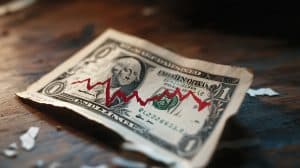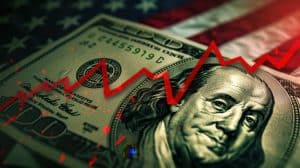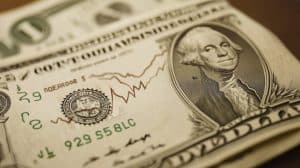US dollar depreciation 2025: What it means for your wallet

Advertisements
The US dollar depreciation isn’t just a headline for economists, it’s a reality that hits your wallet directly. When the greenback loses value, everything from groceries to your travel plans feels the strain.
As the dollar falls against other global currencies, it triggers a ripple effect: higher prices, diminished savings, and shifting investment opportunities. But what’s behind this shift, and how can you respond smartly?
Let’s break down the forces weakening the dollar and what they mean for your personal and financial life in 2025.
Advertisements
Understanding the factors of US dollar depreciation
To grasp the full impact of US dollar depreciation, it’s important to examine the major forces behind it. In 2025, the drop in value reflects a mix of domestic weaknesses, monetary strategy shifts, and global competition.
Understanding these dynamics helps explain why the dollar no longer holds the strength it once had.
According to recent financial analysis, this isn’t a short-term dip. Structural factors such as persistent inflation, policy hesitations, and widening trade imbalances are combining to drive a noticeable decline in dollar value across international markets.
Advertisements
Inflation remains persistently high
One of the clearest triggers of US dollar depreciation in 2025 has been the steady rise in inflation.
Prices on consumer goods and services continue to climb above expected targets, reducing the purchasing power of the dollar both at home and abroad. Investors are growing cautious as real returns shrink.
Shifting interest rate policies
The Federal Reserve’s reluctance to aggressively raise interest rates has impacted dollar strength. Other central banks have acted more decisively, making foreign currencies more attractive.
Lower US rates mean less incentive for global capital to flow into dollar-based assets, reducing demand for the currency.
Trade imbalance weakens currency strength
The US continues to import far more than it exports, leading to a consistent trade deficit. This increases the supply of dollars in circulation globally, weakening its relative value.
US dollar depreciation is accelerated when foreign currencies are needed more than the dollar in global trade exchanges.
Declining investor confidence
Concerns about fiscal policy, national debt levels, and slow economic growth have shaken investor faith in the US dollar. As confidence fades, capital moves into other safe havens such as gold, the euro, or the yen.
These shifts in investor behavior put even more pressure on the dollar’s value.
Geopolitical instability and global competition
The rise of new economic powerhouses and mounting geopolitical tensions are also playing a role. Competition from China’s yuan and the strengthening of the eurozone have reduced reliance on the dollar as the default reserve currency.
Global diversification strategies now limit the dollar’s dominance, intensifying US dollar depreciation in long-term projections.
In 2025, understanding the causes behind US dollar depreciation is critical. From inflation trends to investor behavior, every piece of the puzzle reveals how deeply interconnected the dollar is with global economic health.
For anyone managing savings, investments, or business strategy, recognizing these triggers is a step toward better financial planning.
Effects on consumer prices and inflation

The effects of US dollar depreciation go far beyond currency markets. They directly influence how much consumers pay for basic needs and lifestyle products.
As the dollar weakens, imported goods become more expensive, reshaping inflation trends and tightening household budgets.
In 2025, with the dollar falling against global currencies, the average consumer is feeling real financial pressure. From groceries to electronics and travel expenses, the impact of a weaker dollar is reshaping everyday financial decisions.
Inflation rises as imports become costlier
As the value of the dollar drops, goods imported from overseas become more expensive in dollar terms.
Since the US heavily depends on foreign manufacturing for food ingredients, electronics, fuel, and consumer products, this translates to widespread inflation.
Import inflation has already contributed to significant price increases in 2025.
According to recent market data, food prices have risen more than 4 percent year over year, and tech products are facing delayed shipments and higher costs due to currency-adjusted contracts.
Household budgets lose purchasing power
When US dollar depreciation takes hold, each dollar loses strength, meaning consumers must spend more to maintain the same lifestyle. This affects everything from grocery store trips to online shopping.
With prices climbing, families are forced to make choices. Many are turning to private-label or generic brands, postponing discretionary spending, and cutting back on non-essential services.
The dollar’s weakness is visibly shaping consumption habits across income levels.
Sectors hit hardest by price hikes
Some sectors are disproportionately affected by dollar fluctuations. The food and beverage industry faces rising costs for imported ingredients, especially those tied to international agriculture or specialty goods.
Restaurants and supermarkets have passed these costs to consumers.
The travel and tourism sector also feels the sting. Trips abroad become more expensive as exchange rates move unfavorably. Airlines and hospitality services adjust pricing to offset the higher cost of operations abroad.
In contrast, some domestic manufacturers gain a competitive edge. Their products become cheaper in global markets, boosting exports. Still, many of these same companies rely on imported components, which are now more expensive to acquire.
Adapting to price shifts in a volatile economy
For most people, the reality of US dollar depreciation means adapting spending habits. From revising grocery lists to delaying tech upgrades or travel plans, consumers are rethinking how they allocate income.
Budgeting tools and price-comparison apps have become essential.
Understanding this dynamic helps individuals and families respond proactively. Recognizing how currency shifts filter down into retail prices empowers smarter choices and reduces the stress of navigating a volatile economy.
In 2025, inflation tied to a weak dollar isn’t temporary. It’s a lasting effect that requires attention, planning, and adaptation to avoid deeper financial strain.
Impact on international investments

The impact of US dollar depreciation on international investments is becoming increasingly relevant in 2025.
As the dollar continues to weaken, its influence spreads across global markets, prompting investors to reassess risk, return, and allocation strategies.
With the dollar falling to multi-year lows against the euro, yen, and other major currencies, international opportunities are shifting.
This makes it critical for investors to understand how US dollar depreciation affects both potential gains and vulnerabilities when investing abroad.
Foreign markets become more accessible
One of the immediate effects of US dollar depreciation is the lower entry cost for foreign assets. International stocks, bonds, and real estate appear more affordable in dollar terms, encouraging investors to diversify globally.
Emerging markets, in particular, become attractive as they offer both growth potential and value during periods when the dollar is under pressure.
Investors often take advantage of favorable exchange rates to reposition their portfolios with global exposure.
Global diversification also serves as a hedge. As the dollar weakens, assets denominated in stronger foreign currencies may hold their value or even increase in worth when converted back into US dollars.
Currency risk becomes a critical factor
Despite the appeal of foreign assets, US dollar depreciation introduces new risks. Currency volatility can reduce or reverse gains once investments are repatriated.
Even strong asset performance abroad may be offset by exchange losses when converting back into a weaker dollar.
Additionally, political instability in emerging economies or inconsistent monetary policies can amplify exposure.
These variables add complexity to investment decisions, making it essential to monitor both local and international economic indicators.
Many investors are now turning to currency-hedged funds or multi-currency portfolios as a way to minimize exchange-rate losses while still benefiting from international growth.
Inflation and interest rate gaps affect returns
Differences in inflation and interest rates between the US and foreign markets also play a major role. Countries with rising inflation may experience reduced purchasing power, which can limit real returns despite nominal asset growth.
On the other hand, foreign economies with stable inflation and competitive interest rates often provide better long-term value.
As the dollar depreciates, these contrasting conditions create a shifting landscape where traditional benchmarks no longer apply.
Understanding how US dollar depreciation interacts with inflation dynamics across countries helps investors make more informed decisions about where to allocate capital.
Global strategies must adapt to currency shifts
In 2025, global investors are learning that ignoring currency movements is no longer an option. US dollar depreciation is reshaping the landscape of cross-border investment, requiring sharper analysis and more flexible strategies.
Whether investing in international ETFs, direct foreign equities, or real estate abroad, adapting to the realities of a weaker dollar is key.
Those who understand the full impact of US dollar depreciation can protect their portfolios and potentially unlock new growth opportunities in a rapidly changing global market.
How different sectors respond to currency changes
The influence of US dollar depreciation goes far beyond currency exchange rates. It reshapes the behavior of entire industries, depending on how each sector interacts with global trade, raw materials, and foreign capital.
In 2025, this has become even more evident as companies adjust operations to respond to a weakened dollar.
While some sectors benefit from increased global demand, others face higher costs, tighter margins, and operational challenges.
The strength or weakness of the dollar determines pricing power, market expansion, and the long-term resilience of each industry.
Import-heavy sectors struggle with rising costs
Industries that rely heavily on imported goods, such as consumer electronics, fashion, and household products, are among the first to feel the financial pressure of a declining dollar.
As the US dollar loses value, foreign suppliers demand more in return, forcing American companies to either raise retail prices or absorb the losses.
In 2025, electronics manufacturers are paying significantly more for components sourced from Asia and Europe.
Retailers across the country have also reported margin erosion, as higher wholesale prices make it difficult to maintain previous price points without discouraging consumers.
This results in reduced affordability for US shoppers and cautious inventory management by sellers. As a result, businesses in these sectors are increasingly looking for alternative supply chains or shifting toward domestic sourcing when possible.
Export-driven sectors gain international advantage
While import-reliant sectors struggle, others benefit from US dollar depreciation, particularly those involved in exports.
American-made goods become more affordable for buyers abroad, increasing demand in international markets for agriculture, industrial machinery, and automobiles.
Farmers and manufacturers are expanding output to meet growing overseas orders. In rural states, grain shipments to Europe and Asia have surged, while automotive exports have risen thanks to competitive pricing.
This shift is helping certain regions recover from previous slowdowns, boosting employment and production rates.
Exporters are capitalizing on this opportunity by strengthening their presence in foreign markets, locking in contracts while the dollar remains weak. The global reach of these businesses grows in parallel with the depreciation of the currency.
Tourism and hospitality experience mixed outcomes
The tourism and hospitality sector offers a more nuanced reaction to US dollar depreciation. A weaker dollar makes the United States a more affordable destination for international travelers.
In 2025, major US cities have seen an uptick in foreign visitors who find their money goes further, resulting in increased hotel bookings and restaurant activity.
At the same time, Americans planning trips abroad are dealing with higher travel costs.
Exchange rates have made international flights, lodging, and even shopping significantly more expensive, which is pushing many travelers to choose domestic vacations instead.
This dual effect benefits US-based travel services while placing pressure on outbound travel agencies and luxury tour providers. Companies in this space are adjusting by marketing to international clients and offering more local travel packages.
Investment-dependent sectors face funding challenges
Certain industries, such as construction, renewable energy, and infrastructure development, often depend on international investment and imported materials.
US dollar depreciation has made these inputs more expensive and slowed the flow of foreign capital into large-scale projects.
Developers and public-private partnerships are facing delays or scaling down initiatives due to elevated costs.
In some cases, investors are redirecting their attention toward markets where currency stability promises better returns, leaving US-based ventures underfunded.
This shift is prompting companies to renegotiate contracts, seek domestic funding, and reevaluate their timelines. While some projects can adapt, others may be postponed indefinitely unless the dollar stabilizes.
In 2025, the varied response to US dollar depreciation shows just how closely business strategy is tied to currency movement.
Each sector must assess its vulnerabilities and advantages to remain competitive, especially in a global economy where financial conditions change rapidly.
Strategies to mitigate the effects on personal finance

When facing the financial impact of US dollar depreciation, having a plan is not optional, it’s essential. The weakening of the dollar influences everything from the cost of groceries to long-term savings.
To stay financially secure, individuals must adapt their habits, investments, and income strategies to protect their purchasing power.
In 2025, price increases and currency instability are becoming the new normal. That’s why it’s more important than ever to be intentional with how you manage your finances in response to a declining dollar.
Adjusting your budget to match inflation
The first and most immediate step is revisiting your monthly expenses. As US dollar depreciation drives up the price of imported goods, many everyday items become more expensive.
Budget reviews help identify where spending can be reduced without compromising essential needs.
Focusing on essentials allows you to make informed trade-offs. For example, choosing more affordable grocery brands, limiting takeout meals, or prioritizing needs over wants can make a difference.
Timing your purchases around seasonal discounts and promotions also helps manage inflated prices.
Over time, consistent adjustments build resilience against prolonged inflation and prepare your finances for further currency-driven volatility.
Diversifying investments to protect long-term value
Inflation and US dollar depreciation can erode the value of stagnant savings. To offset this, consider allocating funds into assets that retain or increase value over time.
Real estate is often viewed as a stable hedge, while commodities like gold tend to perform well in inflationary periods.
Stocks in sectors that benefit from a weaker dollar, such as export-driven industries or energy, may also offer strong growth opportunities. Diversifying across markets and currencies helps reduce dependency on the dollar’s strength.
Before making any investment decisions, it’s wise to review your risk tolerance and consult financial professionals. The goal is not just to grow your money but to shield it from currency erosion.
Expanding income streams for greater flexibility
Another way to manage the effects of US dollar depreciation is by increasing your income. Even modest gains can soften the blow of rising prices. Freelance work, remote side jobs, or selling niche services online are common approaches in 2025.
Pursuing skill development also enhances long-term earning potential. Learning new technologies, certifications, or languages can improve your competitiveness in the job market and open doors to higher-paying roles.
A more flexible income stream provides breathing room, allowing you to adjust your lifestyle without sacrificing stability.
Strengthening your emergency fund as a safety net
During periods of economic uncertainty, an emergency fund becomes one of the most valuable tools in your financial strategy.
As US dollar depreciation increases the cost of surprise expenses, having cash reserves prevents the need for high-interest borrowing.
Ideally, this fund should cover three to six months of living expenses and remain easily accessible. Keeping it in a high-yield savings account ensures that your money retains some value while remaining liquid.
Establishing this cushion reduces stress and empowers you to make thoughtful financial decisions rather than reactive ones.
Staying proactive in a shifting economy
Ultimately, responding effectively to US dollar depreciation means staying alert and proactive. Monitoring inflation, adjusting your goals, and making small but consistent changes allow you to regain control, even in a volatile environment.
Those who adapt early tend to suffer less financial strain and are better positioned to seize opportunities.
With the right strategies, you can safeguard your finances, protect your standard of living, and plan with confidence, no matter what the dollar does next.
Final thoughts: Navigating the era of US dollar depreciation
The ongoing US dollar depreciation in 2025 is not just a financial headline. It directly impacts how much you spend, how you save, and how your investments perform.
With the greenback losing value against major global currencies, individuals are facing rising prices, shrinking purchasing power, and shifting financial strategies.
According to recent insights from Al Jazeera’s economic coverage, the US dollar is falling to record lows due to a mix of inflation, interest rate fluctuations, and weakening investor confidence.
This ongoing US dollar depreciation reflects broader concerns about domestic policy and global trade pressures.
For those invested in international markets, the analysis by IG Group reveals how currency shifts are affecting asset performance across Europe, Asia, and the Pacific.
Investors are reassessing risk and return, while also seeking safer strategies to hedge against further depreciation.
Understanding US dollar depreciation is essential for every consumer and investor today.
Whether you are adjusting your personal budget, planning a trip abroad, or diversifying your portfolio, recognizing the real-world consequences of a weaker dollar can help you make better choices.
Staying informed and flexible allows you to respond proactively to ongoing economic changes and protect your financial well-being in an increasingly uncertain global market.
US dollar depreciation is not just a temporary phase. It’s a signal to reevaluate, adapt, and move forward with clarity and confidence.
FAQ – Frequently Asked Questions about US Dollar Depreciation
What is US dollar depreciation?
US dollar depreciation refers to a decrease in the dollar’s value compared to other currencies, affecting purchasing power and international investments.
How does a weak dollar impact consumers?
A weak dollar typically leads to higher prices for imported goods, resulting in increased costs for consumers and reduced purchasing power.
What strategies can I use to protect my finances from inflation?
You can adjust your budget, diversify investments, explore additional income sources, and build an emergency fund to mitigate the effects of inflation.
How do different sectors respond to currency changes?
Sectors reliant on imports may face rising costs, while export-driven sectors can benefit from increased competitiveness in foreign markets.
Liked the article?